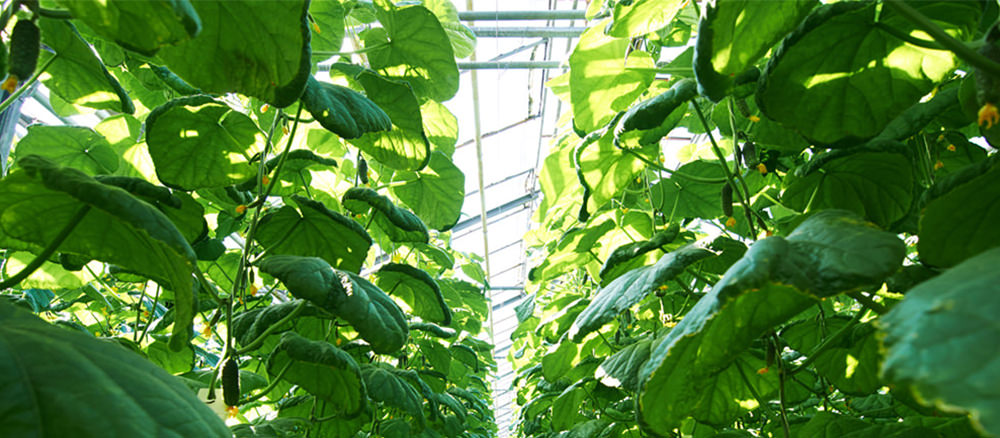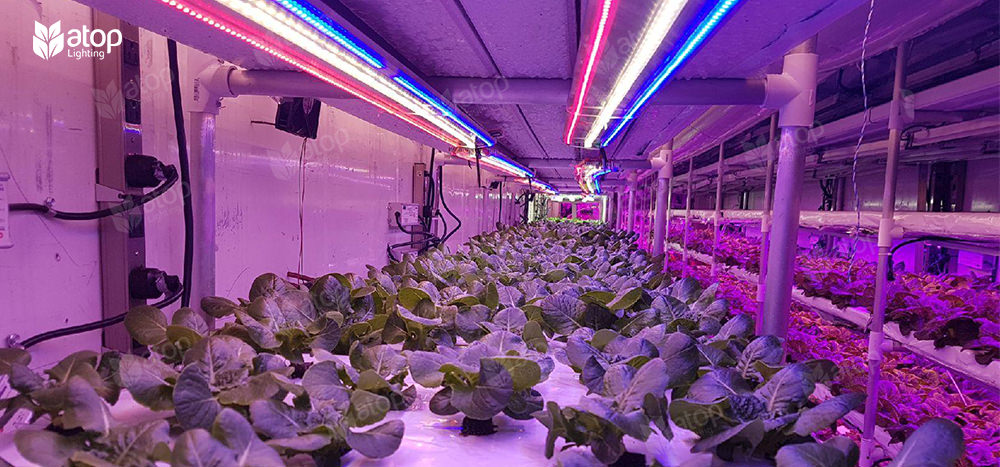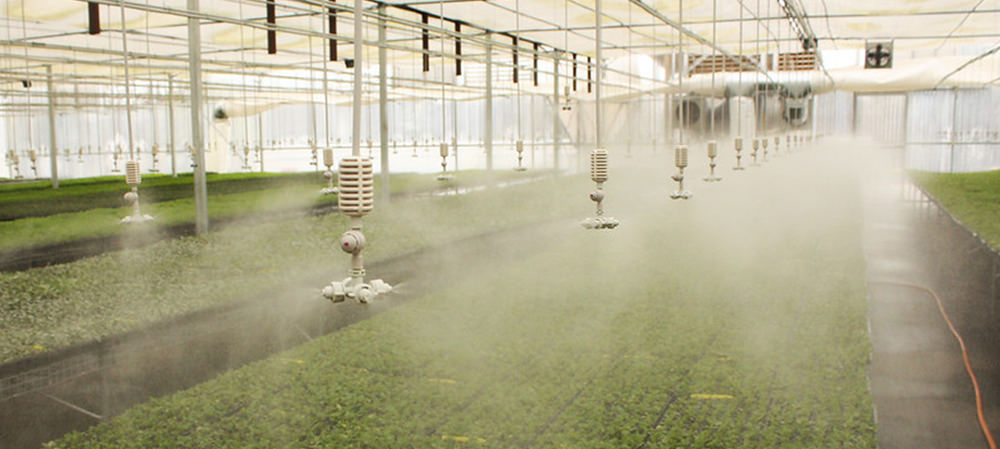Blue Light vs. Chemical PGRs: Which One is Better for Your Crops
Plant growth retardants (PGRs) are a class of compounds that inhibit cell division and expansion in plants. This restricts stem elongation, resulting in shorter, more compact varieties. Growers use PGRs to control the height, shape, and quality of crops.
Traditionally, chemical PGRs have been the go-to choice for many growers, offering predictable results and control over plant development. However, as sustainable practices gain traction, alternative methods are emerging, with blue light taking the spotlight.
Which is the better choice - blue light or traditional chemical PGRs?
In this article, we will compare blue light to chemical PGRs. Discover the advantages and limitations of these methods and gain practical insights that will help you determine the most suitable approach for your crops.

How chemical PGRs work
Chemical PGRs work by interfering with plant hormone pathways or physiological processes, ultimately regulating or inhibiting certain growth responses. These substances act at the cellular level, affecting hormone synthesis, transport, or perception, leading to specific effects on plant growth and development. Here are some key ways in which chemical PGRs work:
- Gibberellin inhibitors: These chemicals, like ancymidol and paclobutrazol, directly interfere with the biosynthesis of gibberellic acid (GA) hormones. GAs regulate cell expansion and division, so inhibiting them suppresses vertical growth.
- Cell division inhibitors: These retardants, like chlormequat chloride, disrupt microtubule formation needed for new cell formation during elongation. This slows cell proliferation.
- Cell expansion inhibitors: Chemicals like dimethipin block processes like water uptake needed for cell enlargement and elongation. Turgor pressure changes suppress growth.
- Auxin transport inhibitors: Chemicals like diflufenzopyr restrict the movement of auxin hormones that stimulate cell expansion. Localized auxin depletion retards growth.
- Growth destabilizers: Quaternary ammonium compounds like CCC destabilize cell membranes to inhibit cell expansion and differentiation.
How blue light works as a PGR
Blue light refers to photons with wavelengths between 400 and 500nm. It can act as a plant growth retardant, especially when crops are grown indoors or in greenhouses under low-light conditions. Blue light works as a PGR by influencing various physiological processes within plants. One of the key mechanisms is its impact on phytochrome photoreceptors. Phytochromes are light-sensitive proteins that regulate plant development and flowering in response to different light wavelengths.
When plants receive a higher ratio of blue light compared to other wavelengths, such as red light, it leads to a suppression of stem elongation and lateral bud growth. This is particularly useful in situations where compact plant growth is desired, such as in ornamental plants or greenhouse cultivation.
Blue light also affects the production and transport of plant hormones, specifically gibberellins. Gibberellins are responsible for promoting stem elongation and cell division. By modulating the levels of gibberellins, blue light helps to inhibit elongation and maintain shorter, more compact plants.
Additionally, blue light can affect the balance of other hormones such as auxins and cytokinins, which further contribute to growth regulation. By altering hormone signaling pathways, blue light can influence branching patterns, lateral bud development, and overall plant architecture.
The precise control over blue light intensity, duration, and spectrum is crucial when using it as a plant growth retardant. LED technology allows growers to fine-tune the blue light parameters to achieve the desired growth retardants, as it allows for more precise and targeted applications.

Blue light VS chemical PGRs
Blue light and chemical PGRs are two types of plant growth retardants that can be used to control plant height and shape. Growers have long relied on chemical PGRs to control factors like plant height, branching, flowering, and yield. But emerging horticultural lighting technologies now offer blue lights as an alternative, non-chemical PGR option. Both approaches have unique benefits and limitations that must be weighed.
Local food regulations
Blue light does not typically have specific regulations in terms of its use for growth regulation. It is considered a natural and non-toxic method, aligning well with sustainability goals and organic farming practices.
The use of chemical PGRs is subject to regulations and restrictions imposed by local food authorities. Growers must adhere to guidelines regarding application rates, pre-harvest intervals, and maximum residue limits to ensure food safety.
Plant growth and development
Blue light and chemical PGRs can both inhibit extension growth by affecting plant hormones, cell division, and cell expansion. However, they can also have different effects on other aspects of plant physiology, such as photosynthesis, photomorphogenesis, flowering, and stress responses. For example, blue light can enhance photosynthesis by increasing the efficiency of light harvesting and electron transport. Blue light can also induce photomorphogenic responses, such as stomatal opening, leaf expansion, chloroplast movement, and anthocyanin accumulation. Blue light can also improve stress tolerance by activating antioxidant enzymes and modulating hormonal signaling.
On the other hand, chemical PGRs can have negative effects on photosynthesis by reducing the activity of enzymes involved in carbon fixation and sugar metabolism. Chemical PGRs can also affect flowering by altering the levels of gibberellins and ethylene, which are involved in floral initiation and development.
Production systems
Both blue light and chemical PGRs can be applied to various crops and production systems, such as greenhouses, indoor farms, vertical farms, and hydroponics.
Blue light requires a suitable lighting fixture that can emit the right percentage, intensity, duration,and spectrum of blue light for each crop. LED technology allows precise control over the light spectrum and intensity, enabling efficient use of energy and space.
Chemical PGRs can be applied through foliar sprays, soil drenches, or seed treatments, making them adaptable to different production systems. However, proper application techniques and compliance with regulations are essential to ensure effectiveness and minimize risks.

Environmental considerations
Blue light is considered environmentally friendly as it does not introduce synthetic chemicals into the ecosystem. It is non-toxic, reduces the risk of chemical residues, and aligns with sustainable farming practices.
The use of chemical PGRs raises concerns about potential environmental impacts; improper application or excessive use can lead to phytotoxicity, groundwater contamination, and adverse effects on non-target organisms. Adhering to label instructions and employing responsible application practices are crucial to mitigating these risks.
Costs
Implementing blue light systems may require an initial investment in LED technology and installation. However, blue light offers long-term cost savings through energy efficiency and reduced reliance on chemical inputs. It also provides the potential for enhanced crop quality, yield, and marketability. For example, blue light can reduce the energy consumption and carbon footprint of lighting systems by using more efficient LED fixtures that emit less heat and more photons. It can also reduce the labor input and chemical use of growers by eliminating or minimizing the need for pruning, pinching, spacing, or spraying. Blue light can also increase crop yield and quality by enhancing photosynthesis, branching, flowering, fruiting, and stress tolerance.
The cost of chemical PGRs varies depending on the specific compounds and application methods used. While they offer precise control over growth processes, their long-term costs can accumulate due to repeated applications and potential regulatory compliance requirements.
Both blue light and chemical PGRs have their place in cultivation. The best approach ultimately depends on your specific crop requirements, cultivation goals, and sustainability objectives.
At Atop, we understand the importance of maximizing crop productivity while maintaining sustainable practices. If you are interested in blue light solutions and how they can be tailored to your specific crop needs, contact us. Our team of experts is here to help you.

